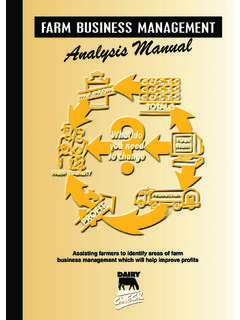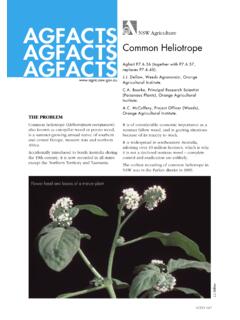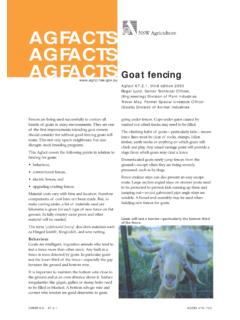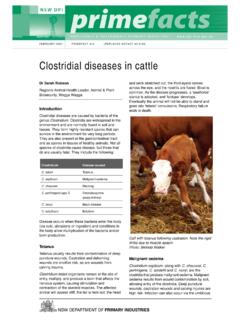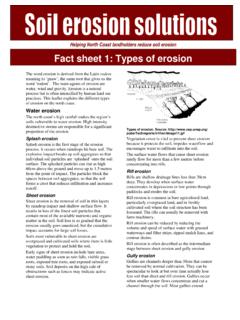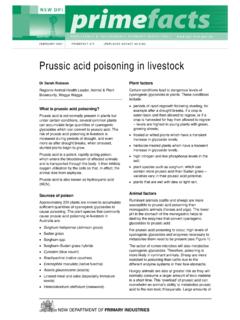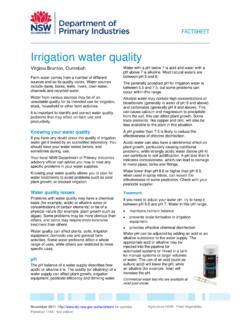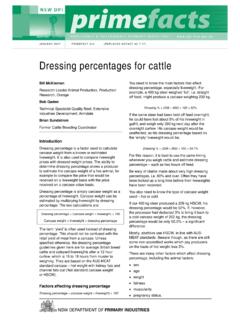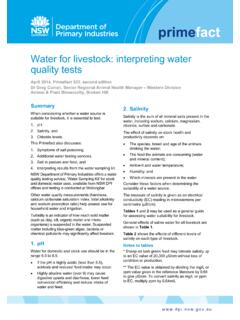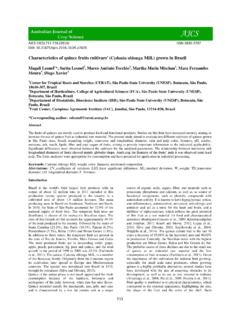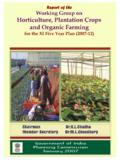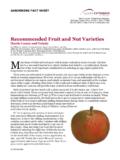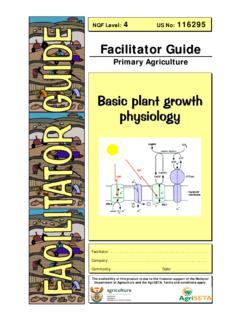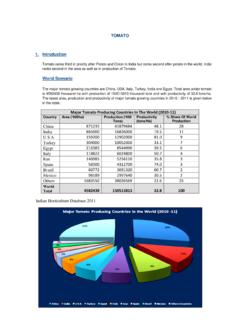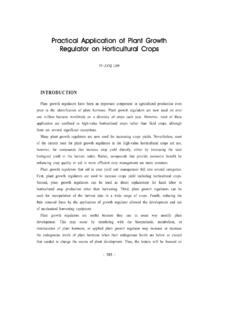Transcription of Common diseases of strawberries - NSW Department of ...
1 SEPTEMBER 2009 PRIMEFACT 892 Common diseases of strawberriesL Ullio Cleanfresh Project, Intensive horticulture , Sydney Markets Leaf scorch Leaf scorch is Common on older leaves and at the end of season, but can also affect leaf stalks, fruit stalks, flowers and fruit. This disease produces small purple spots that first appear on older leaves and gradually enlarge, join other spots and finally produce large dead patches giving the leaves a scorched appearance (Figure 1). Figure 1. Leaf scorch. Affected leaf margins may curl up. This disease is favoured by warm, wet growing conditions and is spread by rain splash, overhead irrigation and wind. disease management: 1. Avoid overhead irrigation if possible. 2. Remove and burn older infected leaves and trash from previous crops near to the new plantings.
2 3. Practise crop rotation. 4. Use protective sprays. 5. Plant disease free runners from an accredited producer. Leaf spot Leaf spot is considered a major disease under suitable conditions. It is mostly a leaf disease , but can attack both leaf and fruit stalks and also fruit. It is identified by small reddish to purple spots, 3 to 5 mm in diameter, with light grey centre which appears on the top side of leaves (Figure 2). Figure 2. Leaf spot. Severe infections can kill the leaf. The symptom on the fruit is a dark brown, sunken spot up to 3 mm wide. Leaf spot is favoured by wet, cooler conditions and is more severe in low lying or shaded areas. The spores are spread by wind, rain splash and overhead irrigation. disease management: As for Leaf scorch.
3 2 PRIMEFACT 892, Common diseases OF strawberries Leaf blight Leaf blight is considered a minor disease of strawberries . It affects mostly mature leaves, but can cause soft rot on ripe fruit. Large round spots develop on leaves with three distinct colour zones. Spots can form a V-shaped area limited by veins that extend to the edge of the leaves (Figure 3). Figure 3. Leaf blight. This disease is at its worst during wet conditions in mid to late summer and in low lying or shady areas. It can be spread from older infected crops by wind and splashing water from overhead irrigation or rain. It can also be introduced from infected runners. disease management: As for Leaf scorch. Black spot Black spot is considered a major strawberry disease that can cause serious crop losses.
4 It mostly affects fruit, but can also affect runners, stalks and crown. This disease produces a round, firm, dark brown, sunken spot on ripening fruit. A white fungal growth can also develop on the fruit (Figure 4). Black spot is spread from infected plants and fruit by rain splash, overhead irrigation and on the hands of fruit pickers. It is favoured by warm, humid and wet conditions. disease management: 1. Plant runners from accredited runner nurseries. 2. Apply protective fungicides when conditions favour the disease . 3. Avoid using overhead irrigation. 4. Cool fruit after harvest. Figure 4. Black spot on fruit. Powdery mildew Powdery mildew is considered a moderate disease that can affect fruit, leaves and flowers. This disease produces white patches of web-like growth that develop on both the lower and upper leaf surface.
5 The edges of the leaves may curl upwards. Immature fruit may fail to ripen, become hard, crack and turn a reddish colour with raised seeds (Figure 5). Figure 5. Powdery mildew damage to fruit. Powdery mildew is favoured by warm, dry conditions followed by moisture on leaves from overnight dew or rainfall. Spores can be spread by wind and can over-winter in trash from the previous and current crops. disease management: 1. Remove and destroy trash at end of the season. 2. Plant runners from accredited runner nurseries. 3. Apply protective sprays when conditions favour the disease . Grey mould Grey mould is considered a major fruit rot disease that can cause heavy crop losses. This disease produces fruit rot that can start at any time from early fruit development to after harvest.
6 Figure 6. Grey mould on ripening fruit. Fruit turns brown at the calyx end and the fungus produces a grey cotton-like growth on the surface (Figure 6). Grey mould is favoured by high humidity, mild temperatures and frequent rain. It can also attack flowers, stalks, leaves and flower buds. disease management: 1. Avoid fruit contact with soil. 2. Remove and destroy affected fruit and leaves. 3. Improve air movement around plants. 4. Prevent excess shading of the fruit due to thick foliage. 5. Apply protective sprays when conditions favour the disease . 6. Avoid using overhead irrigation. Fusarium wilt Fusarium wilt is a soil-borne disease that can cause crop losses under warm conditions. It is fast acting as strawberry plants can suddenly wilt and die.
7 This disease affects the outer leaves first; they become yellow and eventually take on a scorched appearance. Younger leaves stay healthy longer during cooler conditions. Fusarium wilt is spread by infected runners, irrigation water and farm machinery. It enters through roots and affects the water-conducting tissues in the crown (Figure 7). Development is favoured by warm to hot growing conditions and when plants are under stress. Figure 7. Water conducting tissue infected in the crown by Fusarium wilt. disease management: 1. Improve soil drainage. 2. Avoid planting in known infected areas. 3. Plant runners from accredited runner nurseries. 4. Apply soil fumigants before planting. 5. Clean farm machinery. 6. Avoid over-watering.
8 Crown rot Crown rot in considered to be a major disease under suitable conditions. It is caused by several soil-borne fungi. Figure 8. Wilting of plant due to crown rot. This rot can cause heavy plant losses in a short period of time. This disease produces some wilting PRIMEFACT 892, Common diseases OF strawberries 3 4 PRIMEFACT 892, Common diseases OF strawberries of leaves and eventual collapse of the plant (Figure 8). It can affect the roots which may turn black and rot. Fungi are spread by infected runners, water (irrigation or rain) and farm machinery. Crown rot development is favoured by warm, wet conditions and waterlogged soil. disease management: As for Fusarium wilt. Rhizopus rot Rhizopus rot (also known as leak) is a fruit rot disease that mainly affects ripe fruit late in the season.
9 It is considered to be a Common postharvest disease (Figure 9). Figure 9. Fruit break down caused by Rhizopus rot. Affected fruit are soft, watery and become covered with grey, white fungal growth with black spore bodies. Juice also leaks from the affected fruit. Rhizopus rot can be spread by wind, overripe fruit left on the plant and crop trash in the soil. Fruit skin needs to be injured for infection. Development is favoured by hot, humid conditions. disease management: 1. Remove overripe fruit in the field. 2. Burn or bury waste fruit from around the packing shed. 3. Cool fruit as soon as possible after harvest and keep at 0 50C. 4. Avoid packing overripe fruit. 5. Use refrigerated transport. Non- disease fruit problems Sunburn The fruit surface loses its red colour and takes on a scalded appearance (Figure 10).
10 Figure 10. Sunburn of exposed fruit. It is caused by fruit being exposed to long periods of hot, dry conditions in the field. It is more Common when plants are water-stressed on clear, sunny days following a period of overcast weather. Crop management: 1. Maintain adequate soil moisture. 2. Provide good leaf canopy. Frogmouth The end of the fruit splits, and fruit is hollow. It is caused by rapid changes in field temperature (Figure 11). Figure 11. Frogmouth of ripe fruit. Crop management: 1. Use less susceptible varieties. Poor pollination This results in distorted fruit shape and is more Common in early crops. It can be caused by wet conditions or frosts during flowering, low bee activity, and the lack of flower movement (Figure 12). Figure 12.
